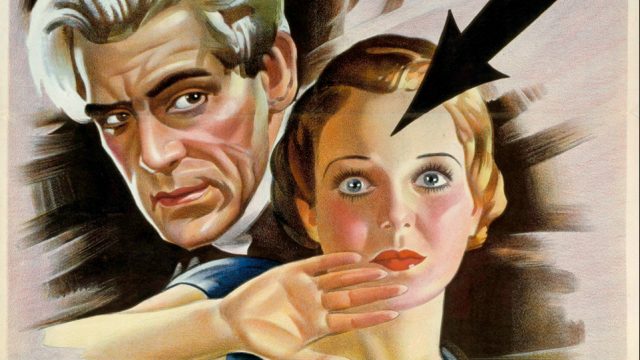The Man Who Changed His Mind is one of only three British horror movies made during the 1930s. It was produced by Gainsborough (under the guidance of Gaumont–British), a studio synonymous with the sweaty, stuffy melodrama that pre-WWII British cinema was known for; the type of movie Truffaut was thinking of when he called “British cinema” an oxymoron. It was directed by Robert Stevenson, a young filmmaker from Buxton who later made Mary Poppins. The Man Who Changed His Mind is a mad scientist movie, and the “scientific” breakthrough that gets horrendously misapplied is the ability to change minds — that is, to scientifically swap minds between two people. In a sense, it’s like if Face/Off was made during the Universal monster era. All the usual suspects are here: a monstrous Boris Karloff; an old, meddling benefactor; a wealthy young man; and an attractive young woman. You can see the entire movie in your head. Or can you?
The name of that young woman is Dr. Clare Wyatt, and she’s played by Anna Lee. When she first appears onscreen, she’s effervescent; she whips her head around to face the camera, her glowing locks recalling Jean Harlow. Yet the second thing she does is shut a dude up. She does it pleasantly and politely because she has no reason to be aggressive with him; she simply no longer wishes to indulge his blathering. Shortly afterwards, she refuses her boyfriend’s marriage proposal because she doesn’t want to leave her job. (She also makes no mention of retiring when she later decides, of her own accord, that she does want to marry him; this was very risqué for the 1930s.) The spurned boyfriend then follows her as she leaves to work with a dangerous scientist — dangerous enough to be played by Karloff — and once she realizes that he’s tailing her, she blithely leaves him in the middle of nowhere, like the nuisance he is. She then calmly rides into thick, ominous fog as if it were a daily routine.
Although most of the men warn her about how dangerous Karloff’s Dr. Laurience is, Dr. Wyatt is the only character who’s never really in any danger. She’s the pragmatic center of a movie that deals with incohesive masculinities. Dr. Laurience, the movie’s monster, is obviously “mad,” just as Henry Frankenstein or Jack Griffin are obviously “mad.” Unlike in Frankenstein or The Invisible Man, however, the ultimate trigger for Laurience’s madness is masculinized social embarrassment. After giving a lecture on his ideas, he is laughed out of the building by his male colleagues, dismissed as a scientist, and cut off by his benefactor. Mirroring the economic hardship that was crippling the UK during the prewar era, Laurience loses his status, his job, and his sense of purpose, all essential components of traditional screen masculinity.
He then immediately kills his benefactor, the jowly tycoon Lord Haslewood, but not before putting the victim’s mind in another man’s body. That other man is Laurience’s friend Clayton, a miserly, wheelchair-bound canker who relishes the ability to walk again. Unbeknown to Clayton, though, his new host has a deadly heart condition, which prevents the newly mobile Clayton from engaging in the masculine social customs of drinking brandy or smoking cigars. On the other side is Dr. Wyatt’s boyfriend, Dick, who looks like a hero — handsome, sharp jawline, sensitive eyes, immense wealth — but behaves like a needy little boy and is eventually trapped by Dr. Laurience. Dr. Wyatt comes to the rescue and vanquishes Dr. Laurience without skipping a beat.
The Man Who Changed His Mind almost seems meta in places; you’d be forgiven for thinking that Anna Lee (Wyatt) and John Loder (Dick) had their minds swapped by Dr. Laurience’s machine. Aside from the fact that Wyatt is the object of everyone’s desires, the masculine–feminine roles of the traditional mad scientist film are precisely inverted. What results is a heroine at a time when that word was often shorter by three letters. Dick, on the other hand, plays the comatose damsel, not dissimilar to Lucy and Mina in Dracula, Madeline in White Zombie, or Joan in The Black Cat. Framing the Man Who Changed His Mind as a feminist movie would be a stretch given how much screen time it devotes to its mostly male cast; it’d be the same as calling Howard Hawks a feminist purely because of Hildy Johnson in His Girl Friday and Sugarpuss O’Shea in Ball of Fire. Simply put, Wyatt is a byproduct of a larger theme.
The good thing about byproducts, though, is that they can be happy accidents. Wyatt’s atypicality doesn’t mean she isn’t subversive. Her characterization itself, from her “blonde bombshell” introduction to her eventual agency, is designed to be subversive. Another horror movie from 1936, Dracula’s Daughter, proves how unusual Wyatt’s characterization actually is, because Countess Zaleska also has agency and is punished for it by her monstrosity. Bride of Frankenstein does the same thing; the fleeting agency the bride enjoys, in which she swiftly appropriates the male gaze, is rewarded with death not five minutes after her introduction. Really, Dr. Clare Wyatt’s closest descendent is the final girl that emerged in the 1970s slasher film. More accurately, she exists somewhere between Sally in The Texas Chain Saw Massacre
and Ripley in Alien.
Unfortunately, the horror genre soon experienced a fallow period that prevented more filmmakers from following in this movie’s footsteps (if they were so inclined). British and American horror film production briefly ended in mid-1936 due to pressures with the BBFC and the Production Code, respectively. Hollywood also found a new genre to play with: the screwball comedy, which gained its name from the marketing materials for My Man Godfrey. Screwball comedies were much more tasteful than horror movies, which made for less political pressure, but they also dealt with more relatable issues such as the new, post-Victorian ideals of marriage that emerged in the 1930s. When horror returned, it was because Dracula and Frankenstein made an unexpected amount of money during their 1938 reruns, and so Universal decided the monster movie was the economic model to guide it into the ‘40s. Starting with Son of Frankenstein, the studio doubled down on every single aspect of the early-30s movies, and, in a formula like that, there was no room for a strong female character like Dr. Clare Wyatt. In time, of course, there would be; after all, The Man Who Changed His Mind makes it obvious that there’s no stopping her.


